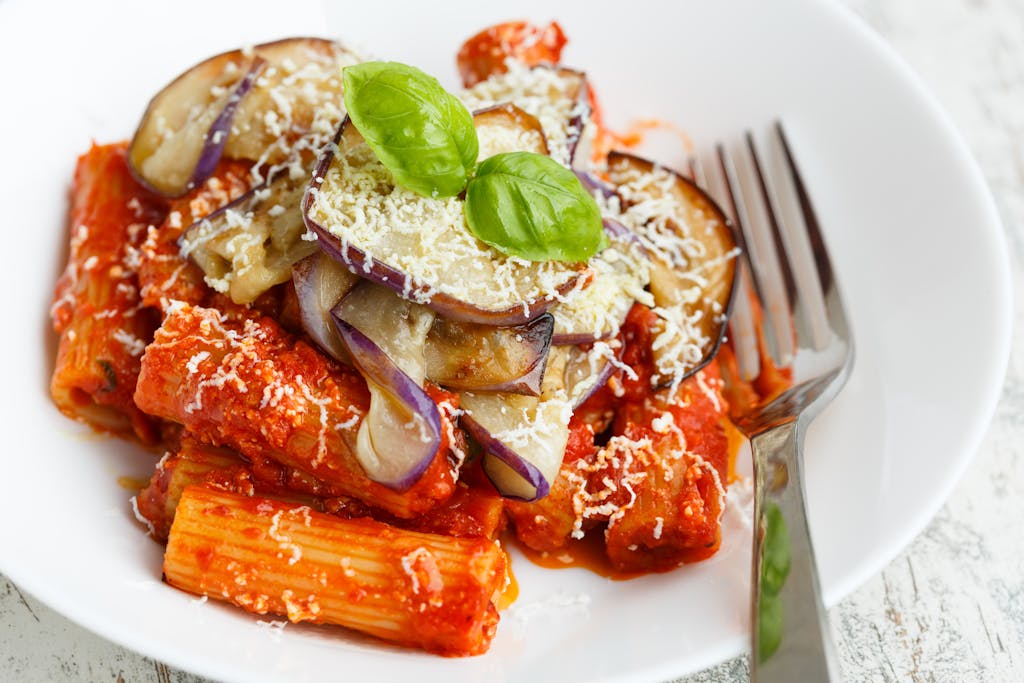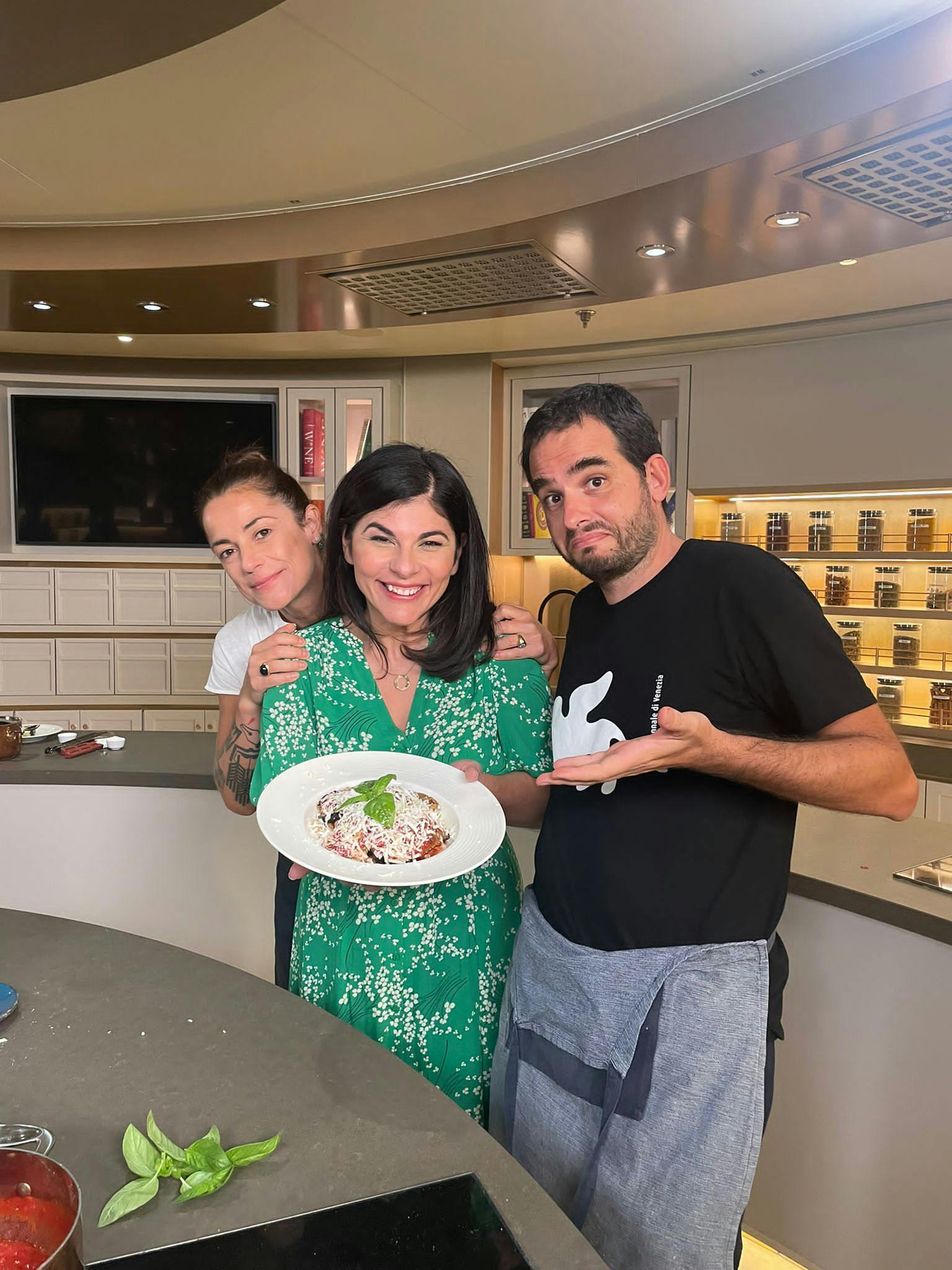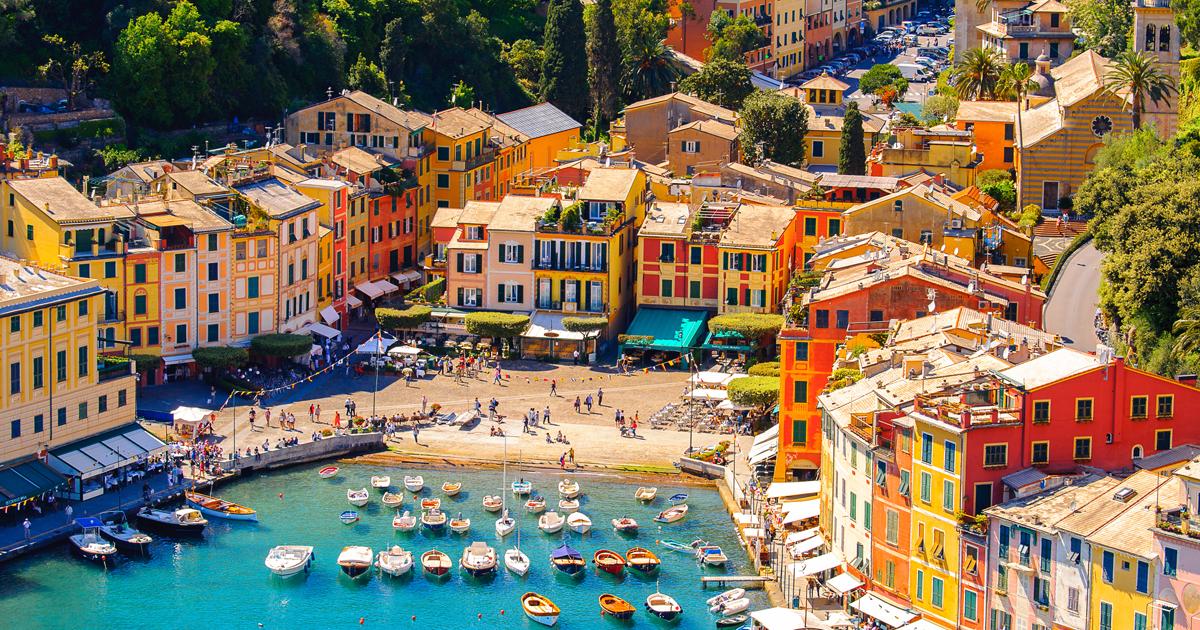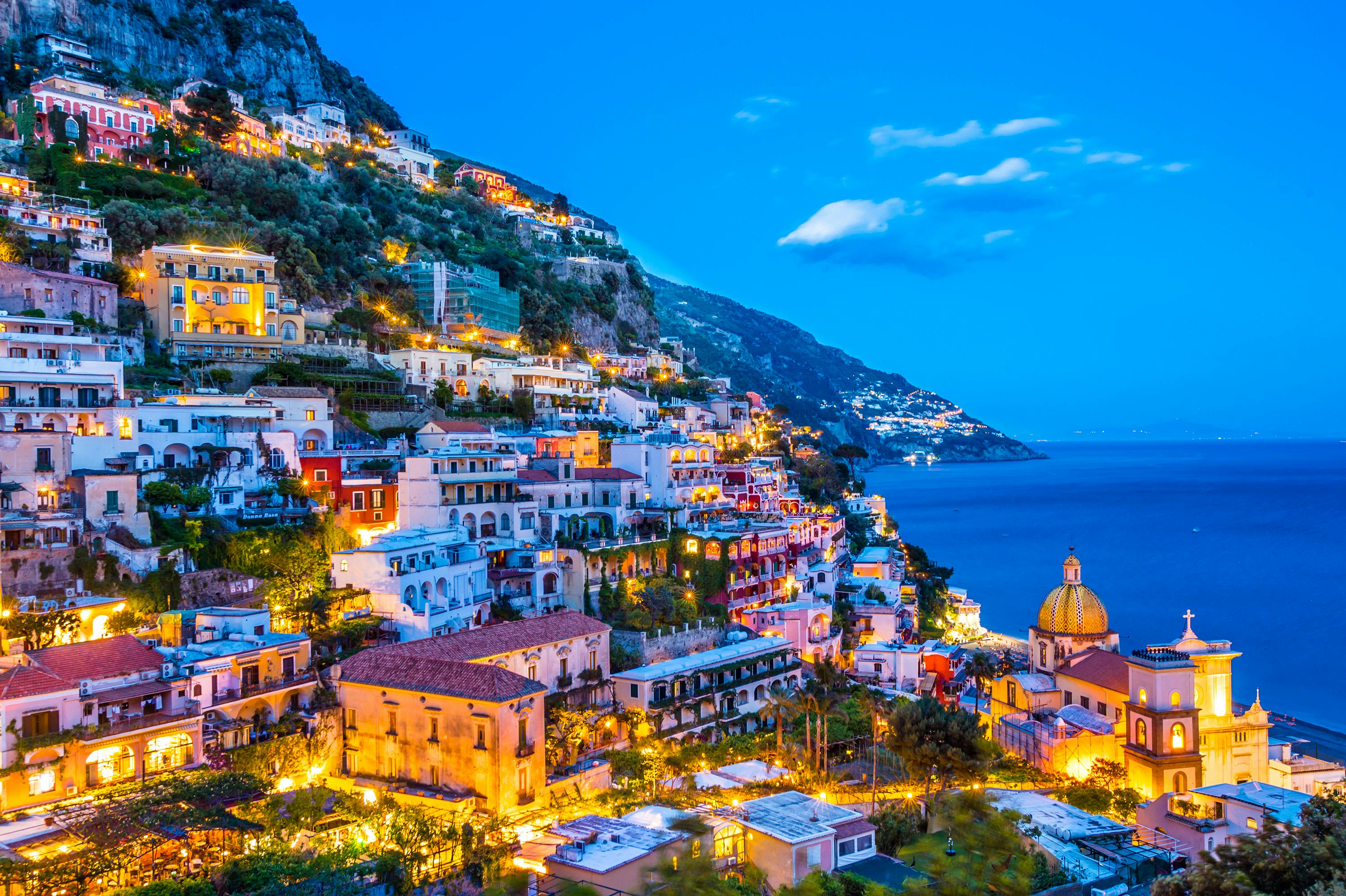S.A.L.T. Lab Lessons: In Sicily, We Make a Proper Pasta Alla Norma
In this series of stories, we share some of the most popular recipes taught at S.A.L.T. Lab, all inspired by our experiences in the Mediterranean. We hope you’ll join us, both on board and off.
Good luck having a decent serving of homemade pasta alla Norma if you’re the youngest sibling in a big Sicilian family. Traditionally, in fact, this iconic primo — made with fried eggplant, tomato sauce and a hefty snowfall of salted sheep’s milk ricotta — comes to the plate in an age-based assemble-it-yourself fashion, seniors first.
Pasta alla Norma was born around 1920, when a quarrel over a play erupted at the house of a theater actor between the host and poet Nino Martoglio. The actor’s wife decided to smooth things over by serving some pasta with homemade tomato sauce, adding a few leftover fried eggplants and some basil from her balcony. It was so good it made Martoglio declare “This is a Norma!”, referring to the famous opera composed by Catania-born Vincenzo Bellini. Well, I can confidently say that whether you’re a fan of opera or not, if you make this recipe you’ll fall in love.
This after all is what food means to us at S.A.L.T. – the reason why we design our shore experiences in a certain way, and why we select specific recipes to make together on board, at S.A.L.T. Lab.
Pasta alla Norma serving etiquette
The pasta (and we’ll get to the minutiae of what pasta exactly should be used shortly) is served in a heaping platter, tossed with tomato sauce and just a little fried eggplant; the remaining slices come stacked sky-high on a separate plate; there is also some extra tomato sauce; then comes the gigantic, quasi-sculptural truncated cone of ivory white ricotta, with its own dedicated grater. Finally, the assembly starts.
Mother and father go first, then brothers and sisters, with the youngest last. Each takes some pasta, then some more tomato sauce, then two or three slices of eggplant: these are shredded directly in the plate, with fork and knife. The youngest is inevitably stuck with the end pieces of vegetable, smaller for sure. The ricotta is grated à la minute. This makes one layer of Norma — layers can keep going, as much as one wants; some start with one layer only, and then go back for seconds and thirds. This “Norma etiquette” is one of many secrets I learned last September, while on location in Sicily with Adam Sachs, global director of S.A.L.T., and Silver Dawn’s Godmother Nilou Motamed, television personality (you may have seen her on “Iron Chef” and “Chopped.” She is also a former editor of Food & Wine and Epicurious).
Our official mission was to shoot two videos for Condé Nast Traveler, showcasing the essence of the S.A.L.T. Sea and Land Taste program. Our unofficial objective in shooting this film was in gathering as much culinary intel — mainly through cooking and eating — as possible. We decided to make pasta alla Norma because it’s one of the signature dishes of Catania, and it has to be one of the best things to do in Sicily. Through its ingredients and history it provides a fundamental entry point into the gastronomic essence of Sicily.
This after all is what food means to us at S.A.L.T. — the reason why we design our shore experiences in a certain way, and why we select specific recipes to make together on board, at S.A.L.T. Lab.
Shop for fresh ingredients
Thanks to our Catanese man on the ground, food stylist Rocco Rossitto (whose father provided the original recipe you’ll find below), we were able to shop like true dialect-speaking locals at “A’ Piscaria” market, famous for its fish selection (not for the faint of heart: there are plenty of bloody water buckets and big crowds). It also has a well stocked selection of fresh greens.
Markets are places where the routes of many products intersect and mingle, and are therefore crucial for understanding how people eat in the area. In Italy, they are also the place where we show off the incredible biodiversity of our produce, including the many existing varieties of eggplant and tomatoes. I love eggplants as does Nilou who, as we made our way through the food stalls, explained the central role they play in the cuisine of Iran, her homeland.
Eggplants actually arrived to the Mediterranean basin through ancient Persia (modern-day Iran) thanks to the Arabs, who also brought the first dried Durum wheat pasta to Sicily in the Middle Ages (tomatoes came from the Americas with the conquistadors). Italian cuisine is the result of a complex layering of cultures and adopted ingredients. But going back to our eggplant: the market vendor schooled us in some of the varieties even I didn’t know about (names often change from region to region). For pasta alla Norma, you want the “nera” or the “seta” variety: dark or light purple, big, firm and oval, they are perfect for yielding long, even slices that fry well.
Then it was the turn of tomatoes. We would have happily left with two basketfuls of the IGP-certified cherry Pachino, but we had to stay on task, so we bought a nice bunch of Roma tomatoes (San Marzano or datterino would also do), firm and juicy, ideal for homemade passata. Our last stop was at the cheese stand where we snatched the last whole “ricotta salata,” a type of ricotta which is salted and then rests for up to three months, losing water and firming up, making it easy to grate. By the way, did you know “ricotta” — literally “twice cooked” — is made by cooking the whey leftover from mozzarella, scamorza and provola?

Cooking tips
With our bounty secured, we made our way to S.A.L.T. Lab onboard Silversea’s Silver Dawn, tied our aprons on and started prepping. Here are a couple of tricks for the eggplants: you want to take off the top and bottom and two sides, then slice parallel to the exposed sides. Once you’re done, salt the slices, pile them up on a plate and press down using a weight. The purpose is not to purge the bitterness — modern varieties of eggplant have been bred for sweetness — but rather to remove excess water and make them absorb less oil during frying (you’re going to rinse and pat them dry before you do.) You want to make sure you have a tomato mill handy, as that’s the best way to make passata (you can also use good quality ready-made passata.)
Finally, secure the right shape of pasta: sedani, maccheroni, penne rigate or “lasagna rizza,” that is “curly” (which is commercially known as mafalda.) We used Feudo Mondello artisanal pasta, made with stone-milled (a rather unique, labor-intensive technique) Sicilian Durum wheat by the Agosta family, who take part in our Palermo S.A.L.T. shorex. After tossing the sedani rigati in our salted boiling water and checking on the slowly simmering tomatoes, Nilou and I talked about the origins of the dish’s name.
Back at S.A.L.T. Lab, with our pasta now ready (al dente!) Nilou and I plated it. We had reserved some of the eggplant frying oil — another pro tip — and drizzled it over the sauce. We topped everything with a couple leaves of fragrant basil. There were only two of us, so there was no need to fight over the best slices of fried melanzana.

PASTA ALLA NORMA
INGREDIENTS / Serves 4
1lb eggplant (2 to 3) of the “Nera” or “Seta” variety (Black Beauty in the U.S.)
7 tablespoons extra virgin olive oil
2lb tomatoes of the Roma, San Marzano or datterino variety
3 cloves garlic
kosher salt for seasoning
7 tablespoons peanut (or sunflower seeds) oil for frying
12 ounces pasta (sedani, maccheroni, penne rigate or mafalde)
¾ tablespoon coarse salt for the pasta water
2 oz ricotta salata cheese
1 large sprig fresh basil
PREPARATION
Slice and salt the eggplants; place a weight on them (see article) and let them “sweat” for 30’. Rinse and pat dry.
Cut your tomatoes and toss in a pan coated with evoo; add in the garlic, whole, unpeeled and smashed with the side of your knife; salt to taste, bring to a simmer and let them soften until half reduced, about 15-20’. Remove from the heat.
In a large pan heat up your frying oil and fry your eggplant slices in batches until golden on both sides (turn them halfway through); reserve some of the frying oil and transfer the fried slices onto a large plate covered in paper towel, barely salting them.
In a large pot bring your pasta water to a boil and salt it; add your pasta and cook it until al dente (normally 2 minutes less than what’s printed on the pasta package.)
Remove the garlic cloves from the tomatoes and pass them through your mill, spooning them in little by little; adjust for salt if necessary, but consider the ricotta and eggplant will also add more salt.
Once your pasta is ready, strain it in a colander and toss it with the tomato sauce, one tablespoon of the reserved frying oil and a few of the eggplant slices.
If you don’t want to do it family-style (see the article), you can assemble each plate individually: pasta first, then more sauce, a drizzle of eggplant frying oil, more eggplant, grated ricotta salata and basil. Enjoy!
Curious about other S.A.L.T. experiences? Learn more here.



















